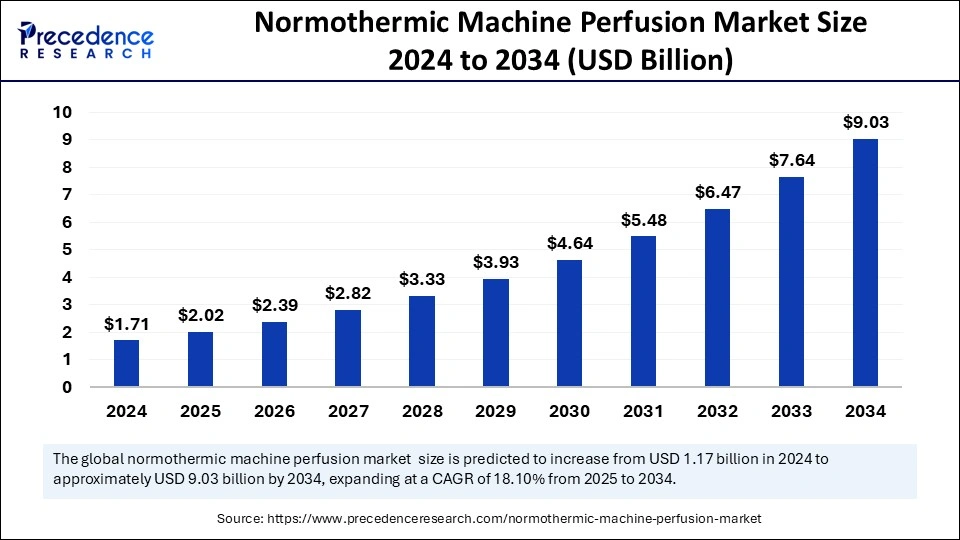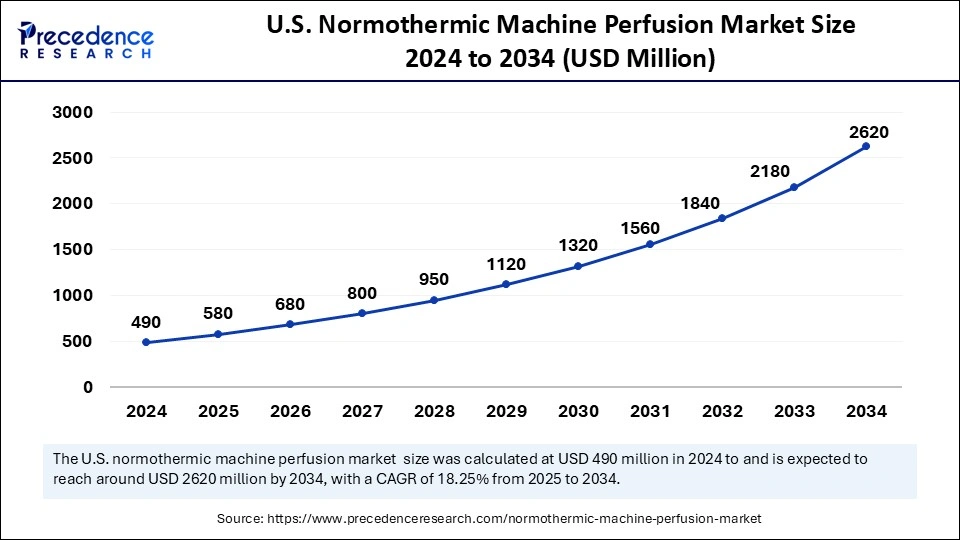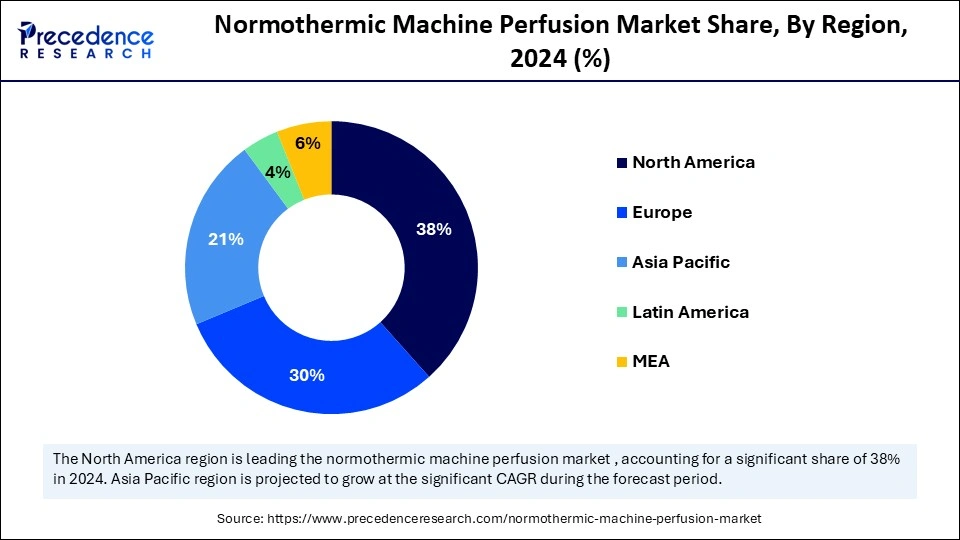February 2025
The global normothermic machine perfusion market size is calculated at USD 2.02 billion in 2025 and is forecasted to reach around USD 9.03 billion by 2034, accelerating at a CAGR of 18.10% from 2025 to 2034. The North America market size surpassed USD 650 million in 2024 and is expanding at a CAGR of 18.26% during the forecast period. The market sizing and forecasts are revenue-based (USD Million/Billion), with 2024 as the base year.
The global normothermic machine perfusion market size accounted for USD 1.71 billion in 2024 and is predicted to increase from USD 2.02 billion in 2025 to approximately USD 9.03 billion by 2034, expanding at a CAGR of 18.10% from 2025 to 2034. The market is driven by rising organ needs, technological advances with regulatory support. Furthermore, the growing understanding of NMP benefits is driving transplant clinics to become important success enhancers while prompting them to implement this technology more frequently.

Normothermic machine perfusion technology benefits from artificial intelligence as an innovative component to develop better organ preservation methods for transplantation operations. The use of AI turns NMP data processing capabilities into improved quality assessments for organs by performing extended examinations of regulatory parameters.
The system maintains ongoing observation functions for the early detection of organ stress signs and protective measures that enhance the standards of organ preservation. The success rate of organ transplants is enhanced when medical professionals decrease both organ rejection instances as well as post-transplant failure occurrences. AI implementation in NMP provides researchers with a superior technique to assess external human organs.
The U.S. normothermic machine perfusion market size was exhibited at USD 490 million in 2024 and is projected to be worth around USD 2.620 billion by 2034, growing at a CAGR of 18.25% from 2025 to 2034.

North America accounted for the largest share of the normothermic machine perfusion market in 2024 because of superior healthcare facilities, high technology adoption rates among healthcare providers, and increasing organ transplant needs. NMP stands as an essential tool within regional transplantation centers because the combination of chronically increasing diseases, population aging, and simultaneous organ shortages drives up the need for improved preservation strategies.
Research and development investments and U.S. FDA support are driving the market expansion in North America while regulatory policies push its growth. The normothermic machine perfusion market in regional healthcare facilities advances because these systems enhance donor organ quality and lower transplant failure rates, while regional organ availability for transplantation provides additional support to market progression.
Asia Pacific is anticipated to witness the fastest growth in the normothermic machine perfusion market during the forecasted years. The expanding need for organ transplants throughout the region makes NMP appear as an effective remedy for maintaining preserved organs while raising transplant success. NMP technology adoption continues to grow because people understand organ donation more, medical facilities become better and healthcare needs to optimize available donor organ usage.

China, India, and Japan are spending to develop their healthcare facilities and transplant programs to enable NMP technology implementation. Hospital providers switch to NMP as a preservation method because the medical community focuses on enhancing patient results, transplant success rates, and solving organ shortages. The rising awareness about NMP, technological innovations, and government support will fuel significant Asia Pacific normothermic machine perfusion market development.
The European normothermic machine perfusion market is expanding substantially because of accelerating public and private investments in research development and the increasing necessity for modern medical equipment. The market receives more traction because of increasing chronic disease rates since these conditions demand organ transplants.
The NMP technology adoption leads mainly through the key European nations including the UK, France, Germany, Spain, and Italy. This regional market features segments based on technique while also sorting products by types and organs but NMP enhances organ viability through transplant outcomes by lowering rejection rates throughout the region.
Normothermic machine perfusion (NMP) functions as an innovative method in organ transplantation to maintain and evaluate donor organs before surgical procedures. A donor organ is perfused through circulation with a warm, oxygenated solution that maintains the temperature at human body levels. NMP pushes the performance of organ preservation and viability assessment, which will likely expand the available organ pool and lead to better transplant results.
NMP addresses the expanding donor organ needs through its ability to lengthen preservation times while maintaining stable organ functioning during the evaluation stage. The normothermic machine perfusion market growth will receive a boost from continuing NMP device progress as well as raising regulatory backing and expanded financial support. The integration of NMP into clinical practice will expand because people are increasingly aware of organ transplantation innovations that aim to increase organ supply and improve patient survival rates.
| Report Coverage | Details |
| Market Size by 2034 | USD 9.03 Billion |
| Market Size in 2025 | USD 2.02 Billion |
| Market Size in 2024 | USD 1.71 Billion |
| Market Growth Rate from 2025 to 2034 | CAGR of 18.10% |
| Dominated Region | North America |
| Fastest Growing Market | Asia Pacific |
| Base Year | 2024 |
| Forecast Period | 2025 to 2034 |
| Segments Covered | Offering, Application, End-User, and Regions |
| Regions Covered | North America, Europe, Asia-Pacific, Latin America and Middle East & Africa |
Increasing organ transplant needs
Organ transplantation needs resulting from aging populations and chronic diseases receive solutions through NMP because this method extends preservation periods. The preservation approaches of NMP have established themselves as an effective solution to improve organ quality. The real-time assessment of organ viability through NMP permits healthcare providers to identify optimal transplantable organs, which increases the total number of used organs.
High initial expenditures
High initial expenditures for NMP equipment systems represent the main obstacle facing the market. The technology requires advanced machinery and specialized solutions at prices that prove excessively expensive for hospitals and transplant centers handling limited budgets. The expensive initial costs associated with NMP equipment prevent some institutions from adopting this.
The complex operation of the normothermic machine perfusion market necessitates trained experts which drives up the need for additional qualified personnel. NMP market expansion faces several obstacles because of long-term effectiveness doubts and cost issues. These barriers lower its market uptake potential.
Collaboration with organ transplant networks
Strategic partnerships with organ transplant network organizations can boost the rate at which normothermic machine perfusion technology gets adopted by the field. NMP manufacturers partner with transplant organizations to obtain larger data volumes featuring different organ types through which they can conduct essential large-scale tests to improve the market.
Working with existing transplant networks enables NMP technology to achieve better incorporation into worldwide clinical operations, which advances its global adoption scope. The collaborative work between networks and NMP providers will fuel innovative development which enhances NMP platform capabilities so they can perform better in future applications.
The products segment donated the largest normothermic machine perfusion market share in 2024. The market shows increasing demand for NMP systems and its required products which include reagents and consumables. The transplantation process requires these products for maintaining organs at conditions that closely resemble human physiology to achieve better functional assessment and extended viability.
The active research and development from important market participants aim to create advanced NMP products that achieve better user efficiency and ease of application. Organ preservation technology developments enhance both organ protection against rejection and increase transplant success statistics. Global adoption will increase because these products will spread more widely throughout transit centers and hospitals.
The services segment is anticipated to show considerable growth over the forecast period. NMP services employ temperature-controlled special machines to supply blood circulation with oxygenated content for keeping donor organs alive under conditions that the human body needs. The technology supports advanced organ preservation by simultaneously maximizing their operational fitness and survival assessment procedures before transplantation.
Healthcare facilities use NMP services to optimize organ preservation and improve transplant outcomes while decreasing post-transplant complications because organ transplantation has become more complex. The services segment showing increasing market demand and understanding of advanced organ preservation techniques will boost the growth of the worldwide transplant infrastructure.
The liver segment captured the biggest normothermic machine perfusion market share in 2024. Organ transplantations keep rising because of expanding rates of continuing diseases that result in liver failure, such as fatty liver disease and hepatitis C.
Through NMP technology, liver allografts maintain their viability after transplantation because it decreases harmful tissue damage and better detects liver performance for optimal organ management. This technology maintains high popularity in transplant centers globally because it improves liver quality during preservation before transplantation.
The kidney segment is expected to grow rapidly during the forecast period. The increasing number of people affected by glomerulonephritis and polycystic kidney disease has caused an elevated need for kidney transplant procedures. The high demand for NMP technology to protect kidney viability emerges from its ability to recreate normal body temperature conditions that minimize tissue damage and extend available organ times.
The normothermic machine perfusion market is expected to experience its most rapid growth through the kidney segment because this technology enables superior organ quality while cutting down rejection incidents and improving post-transplant success rates.
The hospitals and ASCs segment held the largest normothermic machine perfusion market share in 2024. Hospitals and ASCs employ NMP as their primary method for maintaining organs at temperature to delay organ degradation throughout various transplant operations, specifically for liver, heart, lung, and kidney. Key medical organizations within the healthcare sector have launched extended organ recovery programs while providing NMP technology availability for 24-hour operation, which drives increasing institutional demand throughout transplant facilities and hospitals.
The healthcare industry observes growing NMP implementation due to medical facilities striving to enhance transplant results and minimize organ decline. Service providers give access to specific organ recovery services that benefit hospital and ASC operations in organ utilization. The segment will experience substantial growth because the global organ requirements keep increasing, and medical centers use NMP to optimize their transplant operations.
The specialty clinics segment is anticipated to show considerable growth in the market over the forecast period. The growing number of organ transplant clinics continue to use NMP technology to improve organ preservation for livers, kidneys, hearts, and lungs specifically. Such medical centers employ sophisticated new medical practice systems to enhance organ quality, decrease transplantation rejection risks, and boost post-procedure survival statistics.

By Offering
By Application
By End-User
By Region
For inquiries regarding discounts, bulk purchases, or customization requests, please contact us at sales@precedenceresearch.com
No cookie-cutter, only authentic analysis – take the 1st step to become a Precedence Research client
February 2025
April 2025
April 2025
June 2024